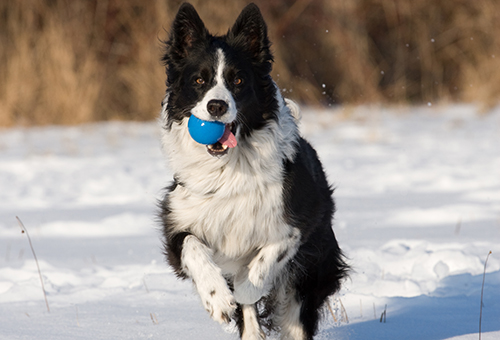How Cold is Too Cold for your Dog?
Jan 31, 2022

During the winter, many of us love to romp around outside in the cool, refreshing air and the fluffy snow. Our dogs don’t like to be left behind, though. Many of them enjoy being outside with us, but when is it too cold for your beloved pet?
Several factors come into play when determining whether your dog will be comfortable staying outside or not. It’s important to remember that no two animals are exactly the same, so outdoor temperatures are going to feel different to every dog.
Fur thickness
A dog’s fur provides insulation for their bodies. Dogs with a thick, double-layered coat such as Siberian Huskies can tolerate much colder temperatures than short-haired dogs such as bulldogs and Great Danes.
Size
Smaller dogs tend to become colder much faster than their larger counterparts. Because they have a larger surface area to volume ratio, heat can escape much more easily from their bodies. Smaller dogs also have less body tissue producing heat.
Bodyweight
Your dog’s bodyweight is another influential factor in determining your dog’s ability to stay warm in the winter. Body fat contributes to your dog’s level of insulation and warmth, so if your dog is a naturally skinnier breed, they are more susceptible to the cold.
Moisture and wind chill
Evaluate weather variables before leaving your dog outside for long periods of time. The same outdoor temperature can feel much warmer on a bright, sunny day than if it is overcast and windy. Also, if your dog has to lay on wet ground, this can jeopardize their ability to stay warm.
Temperature
Most temperatures do not become a problem for dogs until they drop below 45 degrees Fahrenheit. At this point, some dogs may experience slight discomfort, but their health will not suffer. When temperatures fall below 32 degrees Fahrenheit, however, smaller dogs and short-haired dogs should not be left outside for very long. Once temperatures hit 20 degrees Fahrenheit, the potential for your dog to get frostbite or hypothermia significantly increases.
Monitor your dog for signs of discomfort as you determine their ability to withstand the cold. If you notice whining, shivering, slow or weak movements, or searching for places to burrow, it is time to bring your dog back inside. By keeping these factors in mind, your dog is sure to stay happy and healthy all winter!
Your local Co-op has you covered for your pet needs, including special items to help keep them warm this winter! For more content like this, check out the latest issue of the Cooperator.
Several factors come into play when determining whether your dog will be comfortable staying outside or not. It’s important to remember that no two animals are exactly the same, so outdoor temperatures are going to feel different to every dog.
Fur thickness
A dog’s fur provides insulation for their bodies. Dogs with a thick, double-layered coat such as Siberian Huskies can tolerate much colder temperatures than short-haired dogs such as bulldogs and Great Danes.
Size
Smaller dogs tend to become colder much faster than their larger counterparts. Because they have a larger surface area to volume ratio, heat can escape much more easily from their bodies. Smaller dogs also have less body tissue producing heat.
Bodyweight
Your dog’s bodyweight is another influential factor in determining your dog’s ability to stay warm in the winter. Body fat contributes to your dog’s level of insulation and warmth, so if your dog is a naturally skinnier breed, they are more susceptible to the cold.
Moisture and wind chill
Evaluate weather variables before leaving your dog outside for long periods of time. The same outdoor temperature can feel much warmer on a bright, sunny day than if it is overcast and windy. Also, if your dog has to lay on wet ground, this can jeopardize their ability to stay warm.
Temperature
Most temperatures do not become a problem for dogs until they drop below 45 degrees Fahrenheit. At this point, some dogs may experience slight discomfort, but their health will not suffer. When temperatures fall below 32 degrees Fahrenheit, however, smaller dogs and short-haired dogs should not be left outside for very long. Once temperatures hit 20 degrees Fahrenheit, the potential for your dog to get frostbite or hypothermia significantly increases.
Monitor your dog for signs of discomfort as you determine their ability to withstand the cold. If you notice whining, shivering, slow or weak movements, or searching for places to burrow, it is time to bring your dog back inside. By keeping these factors in mind, your dog is sure to stay happy and healthy all winter!
Your local Co-op has you covered for your pet needs, including special items to help keep them warm this winter! For more content like this, check out the latest issue of the Cooperator.